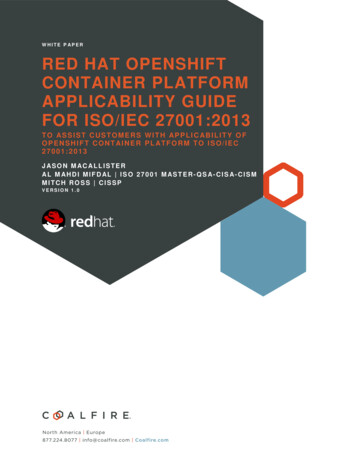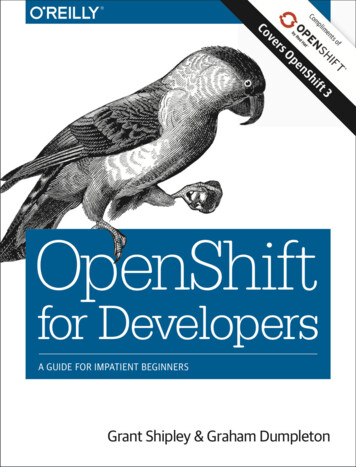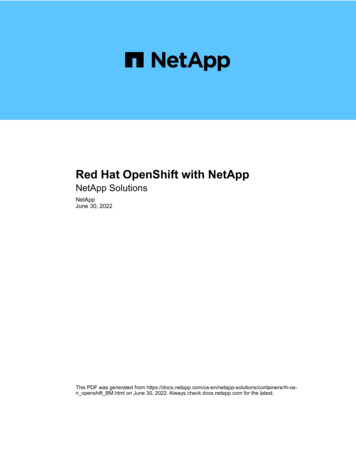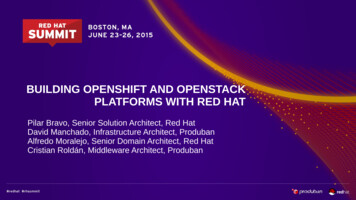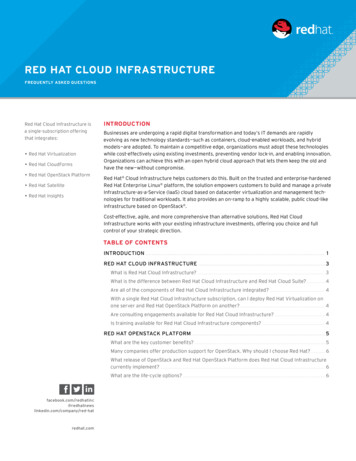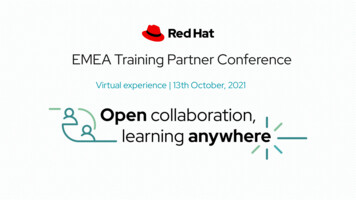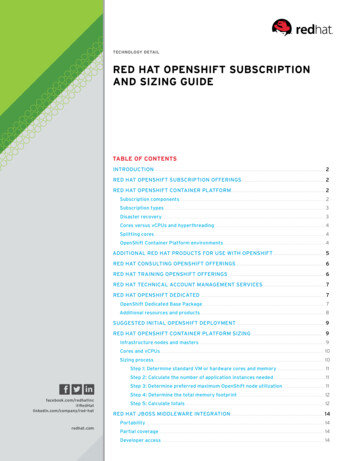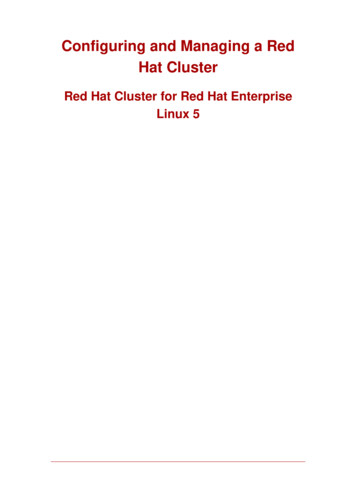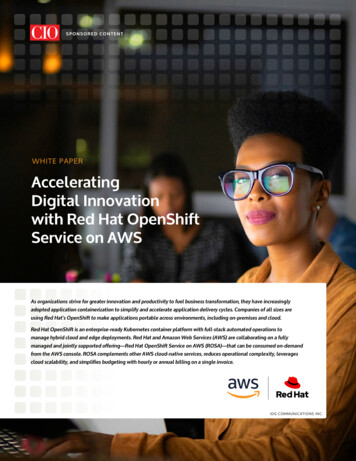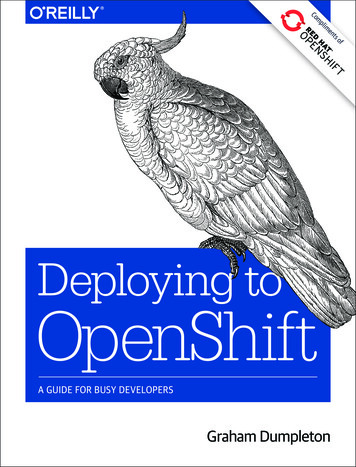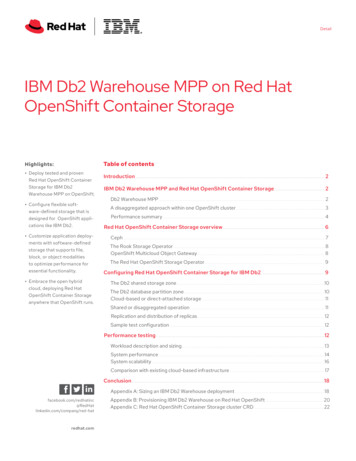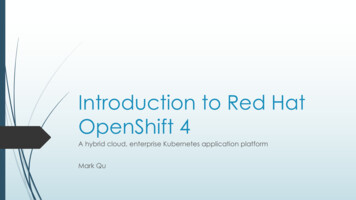
Transcription
Introduction to Red HatOpenShift 4A hybrid cloud, enterprise Kubernetes application platformMark Qu
Agenda About Red Hat IBM and Red Hat Story of Jim Whitehurst Prerequisites before talking about OpenShift What is OpenShift OpenShift vs Kubernetes Features in OpenShift 4 How to get started with OpenShift 4
About Red Hat Founded in 1993 by Bob Young after a merger with Marc Ewing’s company Red Hat Linux Headquarter: Raleigh, NC Started with Linux (Red Hat Linux) Open-source business model: one of the most notable successes in the history of opensource business All Red Hat products are based on open source software Red Hat sells subscriptions for support, training, and integration services Second largest corporate contributor to Linux kernel after Intel Second largest corporate contributor to Kubernetes after Google Major products Red Hat Enterprise Linux (RHEL) Red Hat OpenShift Container Platform (RHCOP) JBoss Revenue 500 million at beginning of 2008 when Jim Whitehurst became Red Hat’s CEO 1.13 billion in 2012 (1st one-billion dollar open-source company) 3.4 billion in 2018
IBM Red Hat Red Hat was acquired by IBM for 34 billion on Jul 9, 2019 Lotus: 3.5 billion, 1995 Informix: 1 billion, 2001 PWC Consulting: 3.5 billion, 2002 Rational: 2.1 billion, 2003 Ascential: 1.1 billion, 2005 FileNet: 1.6 billion, 2006 Internet Security Systems: 1.3 billion, 2006 Cognos: 5 billion, 2008 SPSS: 1.2 billion, 2009 Sterling Commerce: 1.4 billion, 2010 Netezza: 1.7 billion, 2010 Kenexa: 1.4 billion, 2012 SoftLayer: 2 billion, 2013 Trusteer: 1 billion, 2013 Merge Healthcare: 1 billion, 2015 Clearsafe: 1.3 billion, 2015 Truven Health Analytics: 2.6 billion, 2016
IBM Red Hat Since the acquisition, Red Hat remains a separate entity from IBM, to largeextent Red Hat has its own CEO, HR, back office, development, sales, etc. According to Red Hat CEO Paul Cormier, Red Hat has to stay separate topreserve its ecosystem (and culture) What IBM get from the acquisition (personal opinion*) RHEL Generally believed RHEL has at least 2/3 market share in (paid) enterprise server OS OpenShift
Story of Jim Whitehurst Apr 2020 - Present: Present at IBM and chair of board at Red Hat COVID-19 pandemic Why? He gets culture Why not IBM CEO? 2008-2020: CEO at Red Hat Financial crisis Revenue growth: 500 mil 2008 - 1.13 bil 2012 - 3.4 bil 2018 Named one of the World’s best CEOs by Barron’s in 2018 Red Hat: personification of the free-wheeling modern tech industry 2002-2007: SVP and COO at Delta Air Lines Dot-com bubble crash Oversaw Delta’s bankruptcy and recovery “Keep Delta My Delta” Delta: manifestation of classic corporate America 1989-2001: VP and Director of Boston Consulting Group
Prerequisites Container basics https://www.youtube.com/watch?v z ace9c97PE Kubernetes basics (container orchestration) rse/kubernetes-101
What is OpenShift A leading hybrid cloud, enterprise Kubernetes application platform trustedby 1,700 organizations Vendor-neutral Kubernetes platform (AWS, Azure, GCP, VMware vSphere,IBM Cloud, OpenStack, bare metal, etc.) AWS first J Azure next Tags for OpenShift Red Hat Kubernetes Container Cloud PaaS
What is OpenShift – 30-second video(https://www.youtube.com/watch?v xEofcsd6HGg)
History of OpenShift
History of OpenShift
Releases of OpenShift 4VersionGeneral availabilityLife cycle phase4.4May 5, 2020Full support4.3Jan 23, 2020Maintenance support4.2Oct 16, 2019Maintenance support4.1Jun 4, 2019End of life
OpenShift vs Kubernetes: What’s theDifference? Some analogies Car vs Engine Kubernetes is the engine (framework, project) that drives OpenShift OpenShift is the complete car (product) that gets you where you want to Linux kernel vs Linux distribution Kubernetes is the ‘kernel’ of distributed systems OpenShift is the distribution that focuses on the experience of both developers andadministrators Kubernetes plus many other upstream projects project OKD, upstream of OpenShift OKD plus some other projects and RH support product OpenShift
OpenShift vs Kubernetes: MajorOpenShift 4 benefits Trusted OS foundation: RHEL CoreOS or RHEL OpenShift 4 control panel can only be deployed on Red Hat CoreOS (RHCOS) –immutable, lower footprint, optimized for running containers and managingKubernetes clusters at scale Workers can be deployed on RHCOS or RHEL RHEL CoreOS and RHEL make the perfect foundation for OpenShift to runanywhere from bare-metal to private and public clouds with the sameexperience Automated operations Automated installation and day-2 Operations which makes it easier toadministrate, upgrade, and provide an enterprise container platform Ubiquitous usage of operators to make all possible Built-in Operator Lifecyle Manager (OLM) and rich ecosystem of operators
OpenShift vs Kubernetes: MajorOpenShift 4 benefits Cluster services Centralized logs: EFK (ELK) stack Metrics and Monitoring: Prometheus, Grafana Built-in OAuth provider Strict security model, integral RBAC Application services Support microservices and serverless architectures OpenShift Service Mesh provides Istio, Kiali, and Jaeger out-of-the-box to supportmicroservices adoption OpenShift Serverless includes Knative and Keda (for Azure functions) Allow to migrate legacy VMs to OpenShift by using Container NativeVirtualization (tech preview)
OpenShift vs Kubernetes: MajorOpenShift 4 benefits Developer services Built-in OperatorHub which offers a catalog of over 180 services deliveredthrough Operators Developer perspective of web console dedicated to developers Allow easy application deployment from different sources (git source, binary,external registry, Dockerfile, ) Application topology view CodeReady Containers: OpenShift 4 running on laptop Out-of-the-box CI/CD features: Jenkens, Tekton Deep expertise Red Hat has in Kubernetes ecosystem Comprehensive QA process in OpenShift release cycle Professional support Critical bugs fixed earlier than Kubernetes and supported/patched on much longertime frame
OpenShift 4 Architecture
More Detailed Comparison betweenOpenShift and KubernetesOpenShiftKubernetesProduct or projectProduct with paid supportOpen-source projectSupported OSRHCOS and RHELAny LinuxInstallationSimply installation by dedicatedoperator (OpenShift 4)The tool of your choiceSecurityVery strict, built-inauthentication andauthorization model, integralRBAC for longLess strictService provisioningOperator, templatesHelmDeployment approachDeploymentConfig andDeploymentDeploymentRouter vs IngressRouter (and support Ingress toRouter translation)Ingress
More Detailed Comparison betweenOpenShift and KubernetesOpenShiftKubernetesContainer image managementImageStreamIntegrated CI/CDJenkins, Tekton (tech preview),source-to-image (S2I)Project vs namespaceProjects are Kubernetesnamespaces with additionalfeaturesNamespaceUser experience – CLIoc (kubectl plus someconvenient features)kubectlUser experience – web intrefaceNice-looking web console withadmin and developerperspectives, supporting SSO toaccess external servicesPrimitive dashboard UINetworkingNative networking solutionSome components require 3rdparty plugins
Operators Infrastructure as Code (IaC) Probably the most important benefit Kubernetes has enabled Each Kubernetes resource (pod, service, deployment, etc.) is described inmachine readable YAML format (a.k.a., desired status) When the YAML is ‘applied’ to Kubernetes cluster, Kubernetes will ‘make ithappen’ (actual status) If the ‘desired’ status is updated, Kubernetes will make the ‘actual’ statusmatched YAML files can be source-controlled as application artifacts Resources described in YAML format can be easily moved from one place to theother
Operators Introduced by CoreOS in 2016 Operators are powerful extension of Kubernetes’ IaC enablement Innovative approach to automate infrastructure and application managementtasks using Kubernetes as the automation engine Kubernetes Operator Kubernetes-native application Puts all operational knowledge into Kubernetes primitives Administrators, shell scripts, automation software (e.g. Ansible ) now in Kubernetes pods Integrates natively with Kubernetes concepts and APIs Are pods with operator code that interact with Kubernetes API server Run "reconciliation loops" to check on application service Make sure user-specified state of objects is achieved Manage all deployed resources and your application Act as application-specific controllers Extend Kubernetes API with Custom Resource Definition (CRD)
Operators: My UnderstandingInstall operatorOperatorManifestCRDOperatorYAMLCRAPI ServerCreate torPodCR PodCR Pod
Operators: Custom Resource Definition(CRD) A CRD extends Kubernetes API bydefining the schema of a new customresource (CR) Kubernetes API server then has newendpoints for the CRapiVersion: apiextensions.k8s.io/v1beta1kind: : nullname: tomcats.tomcat.apache.orgspec:group: tomcat.apache.orgnames:kind: TomcatlistKind: TomcatListplural: tomcatssingular: tomcatscope: Namespacedsubresources:status: :type: stringkind:type: stringmetadata:type: objectspec:type: objectstatus:type: objectversion: v1alpha1versions:- name: v1alpha1served: truestorage: true
Operators: Custom Resource (CR) Custom Resources (CRs) can becreated based on CRD Operator watches for creation of CRand reacts by creating all resourcesCR representsapiVersion: tomcat.apache.org/v1alpha1kind: Tomcatmetadata:name: mytomcatspec:replicas: 2image: tomcat:latestimagePullPolicy: IfNotPresentwebArchiveImage: sampleapp/webarchive:1.0deployDirectory: /usr/local/tomcat/webapps
Operators: Custom Resource Creationand Management Create CR in OpenShift oc create –f mytomcat.yaml Manipulate and examine CR oc get tomcats oc describe tomcat mytomcat Delete CR oc delete tomcat mytomcat
Operators in OpenShift 4 are Ubiquitous Installation of OpenShift 4 itself Cluster configuration Cluster upgrade (components, host OS) Cluster autoscaling by provisioning or destroying nodes OLM OperatorHub “Everything as Code”
Operators Operator Framework Operator SDK Developers build, package, test operator No knowledge of Kubernetes API complexities required Operator Lifecycle Manager (OLM) Helps install, update, manage life cycle of all operators in cluster Operator Metering Usage reporting for Operators and resources within Kubernetes
Operators OperatorHub.io Kubernetes Internet community for sharing Operators Works for any Kubernetes environment Packages Operators for easy deployment and management Publicizes Operators and enables adoption Uses OLM to install, manage, update Operators
Operators vs Helm
CLI (oc vs kubectl) OpenShift CLI tool ‘oc’ is command compatible with ‘kubectl’ ‘oc’ offers extra features and simplicity ‘oc’ has support of logging in to OpenShift cluster (oc login) ‘oc’ lets you switch your context between projects/namespaces (oc projectmyproject) ‘oc’ allows you to list out your namespaces easily (oc projects) ‘oc’ creates default RoleBindings alongside with a new project (oc new-projectmyproject) ‘oc’ allows you to build container images and deploy applications from sourcecode or binaries (a.k.a., S2I) with one single command (oc new-app)
Web Console Two perspectives Administrator Developer Run as pods
Web Console Topology view Application-centric Shows componentsand status, routes,source code Drag arrows tocreate relationship Add componentsto applicationseasily
Web Console Project details
Web Console Administratoroverview
Web Console OperatorHub
Build and Deploy Container Images inOpenShift Deploy source code Deploy application binary Deploy container image
Deploy Source Code with S2I
Deploy App Binary with S2I
Deploy Container Image
How to Get Started with OpenShift 4 Interactive Learning Portal: http://learn.openshift.com/ Get started with OpenShift: https://www.openshift.com/try CodeReady Containers d-hat-codeready-containers/ Red Hat Online Partner Enablement Network (OPEN):https://connect.redhat.com/en/training
References Red Hat: https://en.wikipedia.org/wiki/Red Hat List of mergers and acquisitions by IBM:https://en.wikipedia.org/wiki/List of mergers and acquisitions by IBM Red Hat CEO Paul Cormier Talks about IBM and His Vision for the is-vision-future Jim Whitehurst: https://en.wikipedia.org/wiki/Jim Whitehurst James /management/james-whitehurst Jim Whitehurst Becomes President of IBM. Why? He Gets -he-gets-culture/#253469c36394 Why IBM Choosing Arvind Krishna Over Jim Whitehurst Was sing-arvind-krishna-over-jimwhitehurst-was-wise
References What is OpenShift: https://www.openshift.com/learn/what-is-openshift What is Red Hat OpenShift? (31-second at-openshift OpenShift: https://en.wikipedia.org/wiki/OpenShift OpenShift success stories: https://www.openshift.com/learn/success-stories/ A brief history of Kubernetes, OpenShift, and ers/blogs/a-brief-historyof-red-hat-openshift/ Red Hat OpenShift Container Platform Life Cycle dates/openshift Kubernetes commit ule kubernetes&date all
References OpenShift and Kubernetes: What’s the t-and-kubernetes-whats-difference Enterprise Kubernetes with OpenShift (Part ernetes-with-openshift-part-one OpenShift vs Kubernetes: What are the t-vs-kubernetes/ 10 most important differences between OpenShift and erences-between-openshift-andkubernetes/ OpenShift vs. Kubernetes: Are they really in s-openshift
References Kubernetes Operators: ykubernetes-operators-ebook-f21452-202001-en 2.pdf Operators: https://www.openshift.com/learn/topics/operators OperatorHub.io: https://operatorhub.io/ Honest review of OpenShift 4: enshift-4/ Tomcat-operator: https://github.com/kube-incubator/tomcat-operator Red Hat OpenShift 4 on your laptop: ift-4-on-your-laptop/ Product Documentation for Red Hat CodeReady Containers red hat codeready containers/1.11/
Thank you!Q&A
OpenShift vs Kubernetes: Major OpenShift 4 benefits Trusted OS foundation: RHEL CoreOS or RHEL OpenShift 4 control panel can only be deployed on Red Hat CoreOS (RHCOS) - immutable, lower footprint, optimized for running containers and managing Kubernetes clusters at scale Workers can be deployed on RHCOS or RHEL
